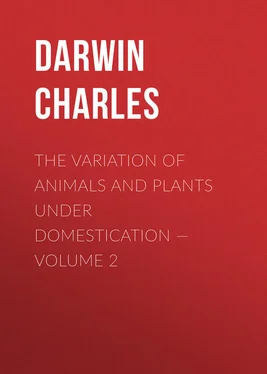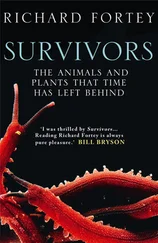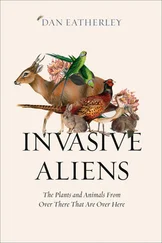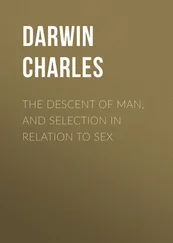Charles Darwin - The Variation of Animals and Plants under Domestication — Volume 2
Здесь есть возможность читать онлайн «Charles Darwin - The Variation of Animals and Plants under Domestication — Volume 2» — ознакомительный отрывок электронной книги совершенно бесплатно, а после прочтения отрывка купить полную версию. В некоторых случаях можно слушать аудио, скачать через торрент в формате fb2 и присутствует краткое содержание. Жанр: foreign_antique, foreign_prose, на английском языке. Описание произведения, (предисловие) а так же отзывы посетителей доступны на портале библиотеки ЛибКат.
- Название:The Variation of Animals and Plants under Domestication — Volume 2
- Автор:
- Жанр:
- Год:неизвестен
- ISBN:нет данных
- Рейтинг книги:3 / 5. Голосов: 1
-
Избранное:Добавить в избранное
- Отзывы:
-
Ваша оценка:
- 60
- 1
- 2
- 3
- 4
- 5
The Variation of Animals and Plants under Domestication — Volume 2: краткое содержание, описание и аннотация
Предлагаем к чтению аннотацию, описание, краткое содержание или предисловие (зависит от того, что написал сам автор книги «The Variation of Animals and Plants under Domestication — Volume 2»). Если вы не нашли необходимую информацию о книге — напишите в комментариях, мы постараемся отыскать её.
The Variation of Animals and Plants under Domestication — Volume 2 — читать онлайн ознакомительный отрывок
Ниже представлен текст книги, разбитый по страницам. Система сохранения места последней прочитанной страницы, позволяет с удобством читать онлайн бесплатно книгу «The Variation of Animals and Plants under Domestication — Volume 2», без необходимости каждый раз заново искать на чём Вы остановились. Поставьте закладку, и сможете в любой момент перейти на страницу, на которой закончили чтение.
Интервал:
Закладка:
How many generations are necessary for one species or race to absorb another by repeated crosses has often been discussed (15/9. Sturm 'Ueber Racen, etc.' 1825 s. 107. Bronn 'Geschichte der Natur' b. 2 s. 170 gives a table of the proportions of blood after successive crosses. Dr. P. Lucas 'L'Heredite Nat.' tome 2 page 308.); and the requisite number has probably been much exaggerated. Some writers have maintained that a dozen or score, or even more generations, are necessary; but this in itself is improbable, for in the tenth generation there would be only 1-1024th part of foreign blood in the offspring. Gartner found (15/10. 'Bastarderzeugung' s. 463, 470.), that with plants, one species could be made to absorb another in from three to five generations, and he believes that this could always be effected in from six to seven generations. In one instance, however, Kolreuter (15/11. 'Nova Acta Petrop.' 1794 page 393: see also previous volume.) speaks of the offspring of Mirabilis vulgaris, crossed during eight successive generations by M. longiflora, as resembling this latter species so closely, that the most scrupulous observer could detect "vix aliquam notabilem differentiam" or, as he says, he succeeded, "ad plenariam fere transmutationem." But this expression shows that the act of absorption was not even then absolutely complete, though these crossed plants contained only the 1-256th part of M. vulgaris. The conclusions of such accurate observers as Gartner and Kolreuter are of far higher worth than those made without scientific aim by breeders. The most precise account which I have met with is given by Stonehenge (15/12. 'The Dog' 1867 pages 179-184.) and is illustrated by photographs. Mr. Hanley crossed a greyhound bitch with a bulldog; the offspring in each succeeding generation being recrossed with first-rate greyhounds. As Stonehenge remarks, it might naturally be supposed that it would take several crosses to get rid of the heavy form of the bulldog; but Hysterics, the gr-gr-granddaughter of a bulldog, showed no trace whatever of this breed in external form. She and all of the same litter, however, were "remarkably deficient in stoutness, though fast as well as clever." I believe clever refers to skill in turning. Hysterics was put to a son of Bedlamite, "but the result of the fifth cross is not as yet, I believe, more satisfactory than that of the fourth." On the other hand, with sheep, Fleischmann (15/13. As quoted in the 'True Principles of Breeding' by C.H. Macknight and Dr. H. Madden 1865 page 11.) shows how persistent the effects of a single cross may be: he says "that the original coarse sheep (of Germany) have 5500 fibres of wool on a square inch; grades of the third or fourth Merino cross produced about 8000, the twentieth cross 27,000, the perfect pure Merino blood 40,000 to 48,000." So that common German sheep crossed twenty times successively with Merino did not by any means acquire wool as fine as that of the pure breed. But in all cases, the rate of absorption will depend largely on the conditions of life being favourable to any particular character; and we may suspect that there would be a constant tendency to degeneration in the wool of Merinos under the climate of Germany, unless prevented by careful selection; and thus perhaps the foregoing remarkable case may be explained. The rate of absorption must also depend on the amount of distinguishable difference between the two forms which are crossed, and especially, as Gartner insists, on prepotency of transmission in the one form over the other. We have seen in the last chapter that one of two French breeds of sheep yielded up its character, when crossed with Merinos, very much more slowly than the other; and the common German sheep referred to by Fleischmann may be in this respect analogous. In all cases there will be more or less liability to reversion during many subsequent generations, and it is this fact which has probably led authors to maintain that a score or more of generations are requisite for one race to absorb another. In considering the final result of the commingling of two or more breeds, we must not forget that the act of crossing in itself tends to bring back long-lost characters not proper to the immediate parent-forms.
With respect to the influence of the conditions of life on any two breeds which are allowed to cross freely, unless both are indigenous and have long been accustomed to the country where they live, they will, in all probability, be unequally affected by the conditions, and this will modify the result. Even with indigenous breeds, it will rarely or never occur that both are equally well adapted to the surrounding circumstances; more especially when permitted to roam freely, and not carefully tended, as is generally the case with breeds allowed to cross. As a consequence of this, natural selection will to a certain extent come into action, and the best fitted will survive, and this will aid in determining the ultimate character of the commingled body.
How long a time it would require before such a crossed body of animals would assume a uniform character within a limited area, no one can say; that they would ultimately become uniform from free intercrossing, and from the survival of the fittest, we may feel assured; but the characters thus acquired would rarely or never, as may be inferred from the previous considerations, be exactly intermediate between those of the two parent-breeds. With respect to the very slight differences by which the individuals of the same sub-variety, or even of allied varieties, are characterised, it is obvious that free crossing would soon obliterate such small distinctions. The formation of new varieties, independently of selection, would also thus be prevented; except when the same variation continually recurred from the action of some strongly predisposing cause. We may therefore conclude that free crossing has in all cases played an important part in giving uniformity of character to all the members of the same domestic race and of the same natural species, though largely governed by natural selection and by the direct action of the surrounding conditions.
ON THE POSSIBILITY OF ALL ORGANIC BEINGS OCCASIONALLY INTERCROSSING.
But it may be asked, can free crossing occur with hermaphrodite animals and plants? All the higher animals, and the few insects which have been domesticated, have separate sexes, and must inevitably unite for each birth. With respect to the crossing of hermaphrodites, the subject is too large for the present volume, but in the 'Origin of Species' I have given a short abstract of the reasons which induce me to believe that all organic beings occasionally cross, though perhaps in some cases only at long intervals of time. (15/14. With respect to plants, an admirable essay on this subject (Die Geschlechter-Vertheilung bei den Pflanzen: 1867) has been published by Dr. Hildebrand who arrives at the same general conclusions as I have done. Various other treatises have since appeared on the same subject, more especially by Hermann Muller and Delpino.) I will merely recall the fact that many plants, though hermaphrodite in structure, are unisexual in function; — such as those called by C.K. Sprengel DICHOGAMOUS, in which the pollen and stigma of the same flower are matured at different periods; or those called by me RECIPROCALLY DIMORPHIC, in which the flower's own pollen is not fitted to fertilise its own stigma; or again, the many kinds in which curious mechanical contrivances exist, effectually preventing self-fertilisation. There are, however, many hermaphrodite plants which are not in any way specially constructed to favour intercrossing, but which nevertheless commingle almost as freely as animals with separated sexes. This is the case with cabbages, radishes, and onions, as I know from having experimented on them: even the peasants of Liguria say that cabbages must be prevented "from falling in love" with each other. In the orange tribe, Gallesio (15/15. 'Teoria della Riproduzione Vegetal' 1816 page 12.) remarks that the amelioration of the various kinds is checked by their continual and almost regular crossing. So it is with numerous other plants.
Читать дальшеИнтервал:
Закладка:
Похожие книги на «The Variation of Animals and Plants under Domestication — Volume 2»
Представляем Вашему вниманию похожие книги на «The Variation of Animals and Plants under Domestication — Volume 2» списком для выбора. Мы отобрали схожую по названию и смыслу литературу в надежде предоставить читателям больше вариантов отыскать новые, интересные, ещё непрочитанные произведения.
Обсуждение, отзывы о книге «The Variation of Animals and Plants under Domestication — Volume 2» и просто собственные мнения читателей. Оставьте ваши комментарии, напишите, что Вы думаете о произведении, его смысле или главных героях. Укажите что конкретно понравилось, а что нет, и почему Вы так считаете.












